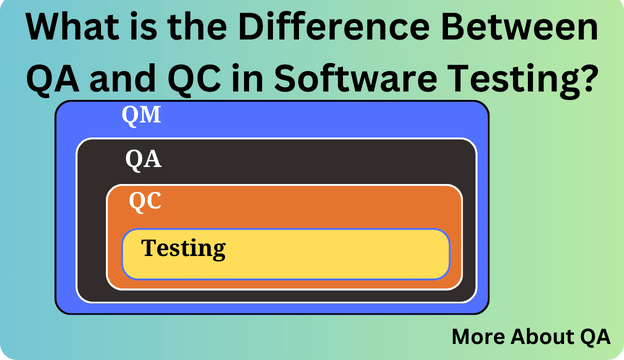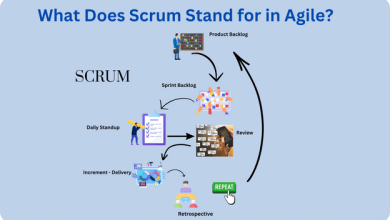
Introduction
You will get clear understanding to answer the question, “What is Difference Between QA and QC in Software Testing?”
The terms “Quality Assurance” (QA) and “Quality Control” (QC) are often used in software testing. QA and QC are important that help us to conforms high-quality software product. Keep it noted that they different from each other and are applied at different phases of the software development life cycle. We shall discuss the distinctions between software testing’s QA and QC in this blog.
| # | QA | QC |
| 1 | QA is a process-oriented | QC is a product-oriented |
| 2 | QA is a managing tool | QC includes activities like, Testing, Test design, test execution etc. |
| 3 | QA is a proactive approach | QC is a reactive approach |
| 4 | QA Focus on Prevention | QC Focus on Detection |
| 5 | QA applies to both the development and testing processes | Testing is a major form of quality control |
What is Difference Between QA and QC in Software Testing?
QA adherence to process while QC is product oriented approach. Read the whole blog to have clear understanding about QA, QC and other related terms.
Quality Management
The Quality Management includes everything that a QA professional does, that is QA and QC.
Quality Assurance
QA involves establishing and implementing standards, guidelines, best practices, and activities to ensure consistent quality throughout the software development and software testing.
- QA adherence to process, meaning that “Are we doing things according to the established process?”
- QA is a managing tool if something goes wrong, the process is revised, and required actions are taken place to avoid misshaping in the future.
- As mentioned in the above table, QA focuses on processes, prevents bugs in the system, and implies software development and testing.
Quality Control
QC is a product-oriented process that identifies bugs in the system. Testing is a major form of quality control, while other activities of QC are testing, test design, test execution, etc.
- It is reactive in nature and detects or finds bugs in the system.
Software Test Process
There are many testing activities that could be performed while testing software, among them there is a common set of test activities that are mostly used to gain the objective of testing. The software test process is the collection of these common testing activities, which are, Test planning Test monitoring and control, Test analysis, Test design, Test implementation, Test execution, and Test completion.
For further understanding about Softwar Testing Process, do visit read this blog.
The Software Test process evaluates the software application and its components to find their compliance with software requirements specifications with the intent to identify defects.
Verification and Validation
Two main activities which helps to check that a software product meets its intended quality and performance standards. These activities comes in both Quality Assurance (QA) and Quality Control (QC).
Verification
It is primarily a QA activity. Verification seeks to answer the question, “Are we building the product, right?” Key points about verification include:
- Preventative in Nature: it aims to prevent bugs in the system.
- Static Processes: These involve activities like code reviews, walkthroughs, and inspections to check for compliance with design and specification documents.
- Carried Out by QA Teams: QA teams are primarily responsible for verification activities.
- Focus on Process Compliance: Verification ensures that the development process follows established standards and best practices.
Validation
It is a QC activity, although QA teams may also play a role in certain aspects. Validation addresses the question, “. Key points about validation include:
- Detective in Nature: Validation is reactive and involves activities such as testing.
- Dynamic Testing: It involves running the software and comparing its actual behavior with the expected behavior to validate its correctness.
- Mainly a QC Responsibility: Quality Control teams, particularly testers, are responsible for validation activities.
- Focus on Product Quality: Validation ensures that the final software product aligns with user needs and provides the desired functionality.
Test Process in Context
Test activities are an integral part of the software development that goes on in an organization where the agile software development model is practiced. Stakeholders fund the software testing, and its final goal is to help fulfill the stakeholders’ business needs. In that way, we do testing depending on numerous factors including:
- Stakeholders (needs, expectations, etc.)
- Team members (skills, knowledge, and level of experience, etc.)
- Business domain (risks, specific legal regulations, etc.)
- Technical factors (architecture, technology used, etc.)
- Project constraints (scope, time, budget, resources, etc.)
- Organizational factors (organizational structure, existing policies, etc.)
- Software development lifecycle (development methods, etc.)
- Tools (availability, usability, compliance, etc.)
Testing process
Here are a few commonly used test processes in software development:
Waterfall Model
In this traditional sequential model, testing comes after the development phase is complete. It follows a linear, step-by-step approach, with testing activities typically occurring at the end of the development cycle.
Agile Testing
Agile methodologies, such as Scrum, incorporate testing throughout the development cycle. Testing activities are continuous, and testing teams work closely with development teams to ensure regular testing and feedback.
V-Model (Validation and Verification Model)
This model emphasizes the importance of verification and validation activities in parallel with development stages. It represents a structured approach to testing, with a focus on early defect detection.
Iterative and Incremental Testing
In iterative development approaches, testing is performed in multiple cycles or iterations, with each iteration building upon the previous one. Incremental testing adds new features or functionality in small increments, allowing for continuous testing.
Continuous Integration and Continuous Testing
These practices involve frequent integration of code into a shared repository, followed by automated testing to ensure that changes do not introduce defects. Continuous testing ensures that the software remains stable throughout development.
Risk-Based Testing
This approach prioritizes testing efforts based on identified risks. Testing focuses on areas of the software that are most critical or susceptible to issues.
Model-Based Testing
Model-based testing uses models to design test cases and generate test scripts automatically. It is particularly useful for complex systems where test case design is challenging.
Exploratory Testing
This informal and dynamic testing approach involves testers exploring the software with minimal pre-defined test cases. Testers use their creativity and intuition to identify defects.
User Acceptance Testing (UAT)
UAT involves end-users or stakeholders testing the software to ensure it meets their requirements and expectations. It is typically the final stage of testing before the production deployment.
To read about Agile test process, do read this blog.
Key Points | What is Difference Between QA and QC in Software Testing
- QM encompasses both QA and QC, focusing on overall quality processes and product quality. It involves planning, executing, and monitoring to ensure the right processes and product quality.
- QA focuses on establishing and implementing standards and best practices to ensure consistent quality in software development and testing processes.
- QC primarily deals with identifying defects in the final product through activities like testing, design, and execution.
Is Testing part of QA?
Testing is one major activity of Quality Control, QC. QC is a subset of QA, so in that context, we can say that yes software testing is part of QA.
Conclusion
To sum up, “what is the difference between QA and QC in software testing?”, QA aims to prevent mishaps in the future by improving processes. QC focuses on ensuring that required tasks are correc and it detects and corrects issues.



Someone essentially assist to make seriously articles I might state.
This is the very first time I frequented your web page
and to this point? I surprised with the analysis you made to make this actual publish amazing.
Great process!